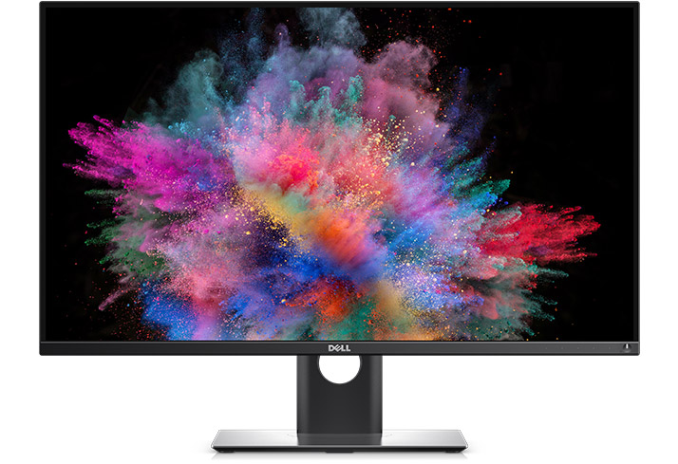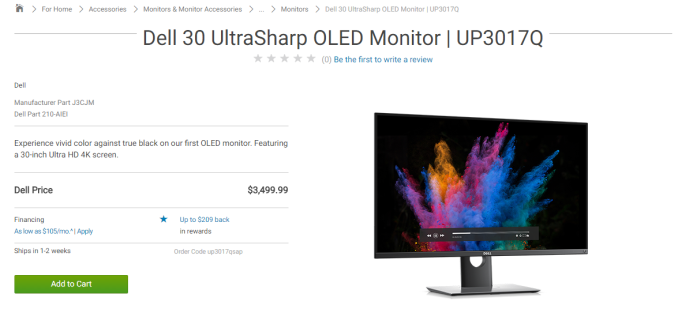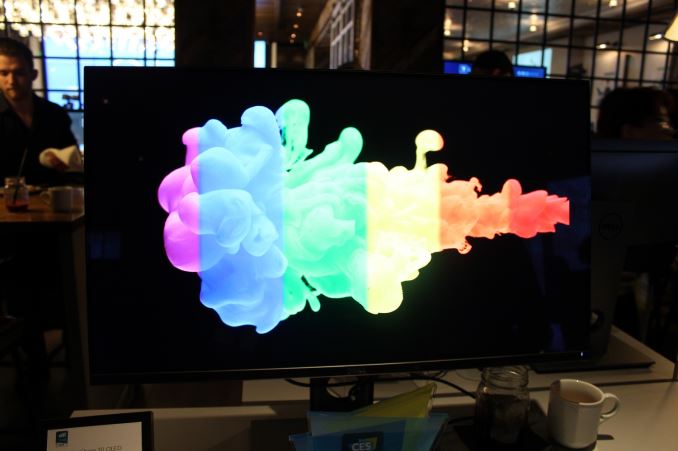Dell’s Ultrasharp 30-inch 4K OLED Now On Sale: UP3017Q for $3500
by Ian Cutress & Brett Howse on April 13, 2017 3:00 AM EST
One of the biggest bits of news to come out of CES 2016, over a year ago, was Dell announcing a new beacon in OLED monitors: a 3840x2160 panel measuring 30-inch diagonal using an OLED display was set to come to market. When we reported on it back at CES, they stated a $4999 price point for March 31st. What happened over the next 12 months was interesting: some journalists doing ‘hands-on’ reviews at tech shows, but nothing coming to retail, followed by plenty of CES 2017 news that the display had been shelved due to image quality issues. Well roll around another quarter, and it seems that Dell is ready to sell it, and shipping for this $3499 beast is only 1-2 weeks away.
| Specifications of the Dell Ultrasharp UP3017Q | |
| UP3017Q | |
| Panel | 76.19cm (30-inch) |
| Native Resolution | 3840 × 2160 |
| Maximum Refresh Rate | 60 Hz |
| Response Time | 0.1 ms (black to white) |
| Brightness | 300 cd/m² (typical) 0.0005 cd/m² (minimum) |
| Contrast | 1000000:1 |
| Viewing Angles | 178°/178° horizontal/vertical |
| Pixel Pitch | 0.1713 mm² |
| Pixel Density | 147 ppi |
| Display Colors | 1.07 billion |
| Color Gamut Support | Adobe RGB: 100% Rec 709: 100% DCI-P3: 97.5% Rec2020: 85.8% |
| Stand | Tilt (5~21°), pivot (+90°, -90°) and height (100 mm) adjustable |
| Inputs | 1 × DisplayPort 1.2 1 × HDMI 2.0 1 × USB Type-C (DP 1.2. PD 100W). |
| Audio | None |
| Launch Price | $3499 |
The Dell UltraSharp UP3017Q is a 30-inch display with a 3840×2160 resolution, response time of 0.1ms, and is set to run at 60 Hz (not 120 Hz as some outlets originally reported). The monitor can reproduce 1.07 billion colors (in this case we assume 10-bit), it covers 100% of Adobe RGB color space as well as and 97.8% of DCI-P3 color space (used for digital movie projection by the U.S. movie industry and is expected to be adopted in televisions and in home cinema), and 85.8% of Rec2020. The manufacturer declares a 1,000,000:1 dynamic contrast ratio, due to the characteristic black of OLED displays.
The UltraSharp UP3017Q is a thin monitor with narrow bezels, but not remarkably thin like OLED TVs, due to the internal power supply unit as well as complex logic inside. The monitor features a mini DisplayPort (mDP) 1.2 connector, an HDMI 2.0 port, and a USB type-C port which can be used for video and data connectivity, as well as power delivery up to 100W.
The Emissive electroluminescent layer in an organic light-emitting diode is made of an organic compound that emits light in response to an electric current. The organic semiconductor layer is situated between two electrodes and does not require a backlight. As a result, it can display deep black levels unlike LCD panels which also use various kinds of backlighting. Curved TVs and monitors are also possible, since the emissive electroluminescent layer is very thin and can take different shapes.
While OLED technology can deliver deep blacks, high contrast ratio and exceptional colors, it is not free of drawbacks. Colors can shift over time, and the organic layer may degrade over prolonged amount of time. To keep the lifespan of the OLED panel maximized inside the UltraSharp UP3017Q, Dell originally advertised a special integrated presence detector into the front panel of the display, which switches the monitor off when nobody uses it, though it is not clear if this is still present. Another disadvantage of OLEDs is a possibility of static image burn-in. The UP3017Q has a special pixel-shifting technology to try and inhibit this.
The Dell UltraSharp 30 OLED monitor will cost $3499 and is available to order in the United States. The display at this point is only aimed at professionals that work in color-critical environments such as graphic arts and photography. However, due to the colors, contrast, and ultra-fast response time, the UltraSharp UP3017Q will be a dream display for gamers, prosumers and other users that value quality.
OLED panels are considerably more expensive to produce than modern LCD panels, partly because of lower yields. In 2015, an executive from LG Electronics said that yields of OLED panels had reached 80% and would continue to grow. At the International CES 2016, Kwon Bong-suk, the head of LG’s TV business, said that the company had cut prices of OLED TVs in the U.S. by 45% late in 2015. As a result, LG expected sales of OLED televisions to triple in 2016. Price reduction of OLED TVs indicates that production costs of organic light-emitting diode panels are going down. Perhaps, over time, the Dell UltraSharp UP3017Q will also become more affordable, or Dell will release an OLED display for a wider audience.
Original Source: @ChrisK101010
Source: Dell













65 Comments
View All Comments
TristanSDX - Thursday, April 13, 2017 - link
with compensation, averge burn-in problem is reduced to 0.5% unevennesshttps://www.hindawi.com/journals/ijp/2013/839301/
guidryp - Thursday, April 13, 2017 - link
It is far from solved. You need to be careful.Check out any display model OLED TV or Phones, they have severe permanent burn in after a few months on display.
Clearly that is terrible usage. but just thing about the Windows Task bar on your screen for years.
dstarr3 - Thursday, April 13, 2017 - link
Burn-in is generally solved. Otherwise everyone would have the Windows taskbar burned into the bottom of their screens.guidryp - Thursday, April 13, 2017 - link
Who is this everyone, who already own OLED monitors?Death666Angel - Thursday, April 13, 2017 - link
Millions of people who have had OLED phones for the past 5 years or so? My old Galaxy Nexus didn't have burn in issues from the task bar even using it 2 years and I'm sure it has only gotten better.Spongie - Thursday, April 13, 2017 - link
I can't speak for all brands, but Samsung phones absolutely experience screen burn in. Ask anyone who uses the Maps app frequently. The UI will permanently burn into the screen.Kamus - Friday, April 21, 2017 - link
Been using my note 4 heavily for years now, there is no burn in.wr3zzz - Thursday, April 13, 2017 - link
As one of the few that use plasma TV as PC monitors, I recommend wait until OLED become more popular to see what happens. My plasma is a late-gen model that supposedly burn-in is no longer an issue but has some serious image retention that might as well be burn-in. Native Windows such as task bar is not an issue. Civilization 4 is absolutely the worst, as well as some older games but nothing compared to Civ4. Certain icons also leave a light mark, such as foobar2000 but not all icons do, and they usually go away after playing the statics for a few hours. Old Netflix used to leave its border lines as well but not the new Windows 10 Store app. Civ4 however have ruined my experience with plasma.cocochanel - Saturday, April 15, 2017 - link
There is a solution to this. My IPS panel would get burn-in from time to time. So, I developed a good habit. Any time I walk away from my desktop for more than an hour, I turn off the monitor. Most of them have a push button for this ( on my monitor is on the lower-right corner ). Besides, it would save you a few dollars a month on your power bill plus being friendly to the environment. LCD's are nowhere near the old CRT's in power consumption, but still, if you're going to leave them on 24/7, it's going to cost you.Frenetic Pony - Thursday, April 13, 2017 - link
"Look it has full HDR color gamuts!" says INSERT PANEL MANUFACTURE. "Oh, so you can master HDR content on it, and view HDR content on it, and-" IPM: "Uhhh, I mean. Well, see the thing is..."And for $3,500 too? WTF On earth is it that allows "TVs" to put out 1000nits or more but not "monitors". Seriously.